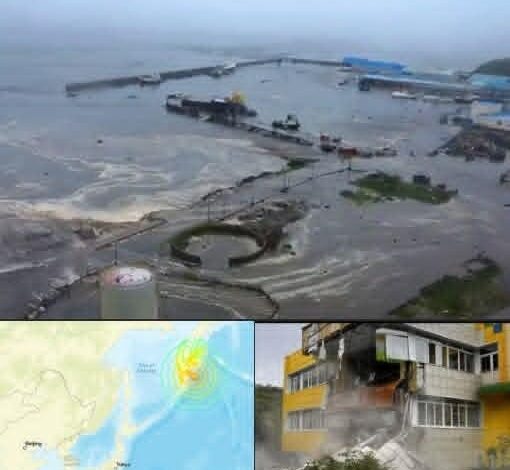
BREAKING NEWS Alert, Powerful 7,7 magnitude earthquake!
A powerful earthquake measuring 7.7 on the Richter scale struck early Monday morning, sending shockwaves across Asia and leaving a trail of destruction in its wake. The tremor, which rattled southern China, northern Thailand, and parts of Myanmar, has already claimed dozens of lives and left hundreds injured. Thousands more are feared to be trapped beneath rubble as rescue teams race against time.
According to the U.S. Geological Survey (USGS), the quake struck at 3:42 a.m. local time. Its epicenter was located in a remote, mountainous area along the China-Myanmar border, but the force of the tremor was felt across hundreds of miles. Because the quake occurred at a shallow depth of only 10 kilometers, its destructive power on the surface was amplified. Buildings crumbled, infrastructure buckled, and communities were shaken awake by one of the most severe natural disasters to hit the region in years.
Immediate Human Cost
Initial reports confirm dozens of fatalities, though officials fear the numbers will climb sharply as assessments continue. Hundreds have been injured, many suffering broken bones, head trauma, and burns from gas line explosions triggered by the quake. Survivors describe scenes of chaos: apartment blocks reduced to rubble, shops collapsing onto busy streets, and families frantically searching for missing loved ones in the debris.
Hospitals in affected areas are overwhelmed. Doctors and nurses are working tirelessly, treating patients in hallways, parking lots, and makeshift triage centers. With medical supplies running low, local authorities are calling for urgent assistance from international relief agencies.
Northern Thailand on Alert
Cities in northern Thailand, including Chiang Rai and Chiang Mai, experienced the quake’s full force. Buildings swayed violently, sending residents fleeing into the streets. Authorities quickly ordered mass evacuations in high-risk zones, worried about structural weaknesses that could collapse during aftershocks. Schools, government offices, and transportation hubs have been shut down as a precaution.
Tourists in Chiang Mai reported frightening scenes as hotel walls cracked and power outages plunged neighborhoods into darkness. Airports in the region remain operational but are under heightened inspection for possible runway and terminal damage.
Myanmar and China Bear the Brunt
On the Myanmar side of the border, villages near the epicenter have been devastated. Entire neighborhoods have been flattened, and communication with rural areas has been cut off due to downed cell towers and damaged power lines. Relief efforts there are further complicated by poor road access and ongoing political instability in some regions.
Southern China has also reported widespread destruction, with collapsed highways, buckled bridges, and landslides cutting off access to remote communities. Authorities have mobilized thousands of soldiers and volunteers to assist with search and rescue operations. Emergency shelters are being set up to house the displaced, offering food, water, and temporary protection to families who lost their homes.
Rescue Efforts and Challenges
Response teams are working under dire conditions. Collapsed infrastructure and blocked roads are slowing the arrival of heavy machinery needed to lift debris. In some areas, rescuers are forced to dig with bare hands to reach those trapped beneath rubble. Electricity blackouts and disrupted water supplies are making conditions even harsher for survivors and relief workers alike.
Adding to the anxiety, aftershocks continue to rattle the region. Seismologists have recorded more than a dozen smaller tremors since the initial quake, some strong enough to topple already weakened buildings. Residents remain on edge, fearful that the worst is not yet over.
International Response
Governments across Asia have pledged coordinated relief efforts. China, Myanmar, and Thailand are working together despite political tensions, recognizing the urgency of the humanitarian crisis. Neighboring countries, including India and Japan, have offered support in the form of medical supplies, rescue teams, and financial aid. International organizations like the Red Cross and the United Nations have also mobilized, preparing to deliver food, tents, and other essentials to the hardest-hit areas.
Expressions of solidarity have poured in from leaders around the world. Relief appeals have been launched, urging the global community to contribute resources for what is likely to become a long-term recovery process.
A Stark Reminder
This disaster serves as a sobering reminder of the region’s vulnerability to seismic activity. The mountainous border area where the quake originated lies along a tectonic fault zone known for violent geological shifts. Experts have long warned that inadequate infrastructure, rapid urbanization, and limited disaster preparedness could lead to catastrophic consequences if a major quake struck.
For the millions affected, the focus now is survival and recovery. Families are reeling from loss, communities are coming together in resilience, and exhausted rescue workers are pushing forward despite immense challenges. The full scale of the devastation is still being assessed, and officials caution that the death toll could rise significantly in the coming days.
Looking Ahead
As the dust begins to settle, questions about rebuilding, disaster preparedness, and international cooperation will loom large. But for now, the priority remains clear: save as many lives as possible, care for the injured, and provide relief to the countless people who have lost everything in an instant.
This 7.7-magnitude earthquake has scarred three nations, tested the resolve of their people, and highlighted the urgent need for global solidarity in the face of natural disasters. The road to recovery will be long and difficult, but the human spirit, as history has shown time and again, remains unbreakable even in the darkest of times.




